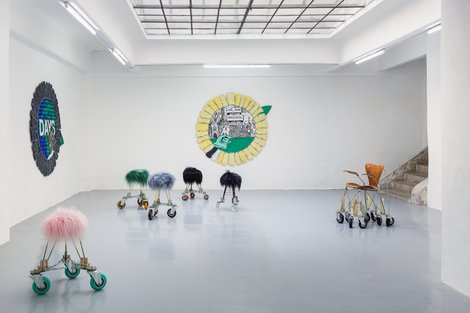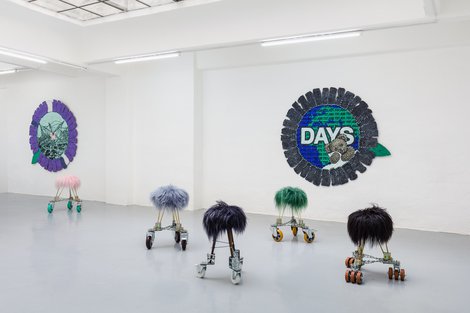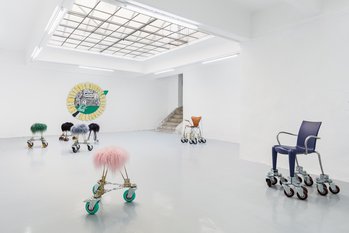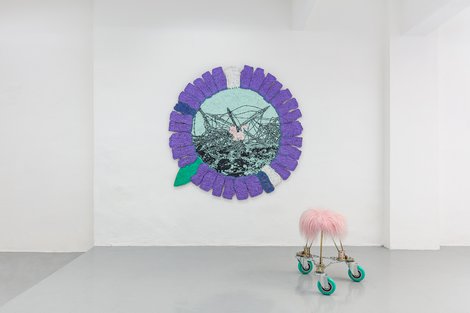Severance
Marina Faust & Sebastian Jefford
Marina Faust & Sebastian Jefford
GIANNI MANHATTAN is pleased to present Severance, a duo exhibition with Marina Faust (AT) and Sebastian Jefford (UK).
‘If Fuzhou Nighttime Feeling were a sound, it would be early/mid-nineties R&B. If it were a flavor, it would be the ice-cold Pepsi we drink as we turn down tiny alleyways where little kids defecate wildly. It is the feeling of drowning in a big hot open gutter, of crawling inside an undressed, unstanched wound that has never been cauterized.’
—Ming La, Severance, 2018.
How does a group of people remember their past? When does an image become engrained or become tangible?
‘If Fuzhou Nighttime Feeling were a sound, it would be early/mid-nineties R&B. If it were a flavor, it would be the ice-cold Pepsi we drink as we turn down tiny alleyways where little kids defecate wildly. It is the feeling of drowning in a big hot open gutter, of crawling inside an undressed, unstanched wound that has never been cauterized.’
—Ming La, Severance, 2018.
How does a group of people remember their past? When does an image become engrained or become tangible?

25.03.21—28.05.21
GIANNI MANHATTAN, Wassergasse 14, 1030 Vienna
> Installation views
GIANNI MANHATTAN is pleased to present Severance, a duo exhibition with Marina Faust (AT) and Sebastian Jefford (UK).
‘If Fuzhou Nighttime Feeling were a sound, it would be early/mid-nineties R&B. If it were a flavor, it would be the ice-cold Pepsi we drink as we turn down tiny alleyways where little kids defecate wildly. It is the feeling of drowning in a big hot open gutter, of crawling inside an undressed, unstanched wound that has never been cauterized.’
—Ming La, Severance, 2018.
How does a group of people remember their past? When does an image become engrained or become tangible?
‘If Fuzhou Nighttime Feeling were a sound, it would be early/mid-nineties R&B. If it were a flavor, it would be the ice-cold Pepsi we drink as we turn down tiny alleyways where little kids defecate wildly. It is the feeling of drowning in a big hot open gutter, of crawling inside an undressed, unstanched wound that has never been cauterized.’
—Ming La, Severance, 2018.
How does a group of people remember their past? When does an image become engrained or become tangible?
Pressing flowers in the Victorian age was considered a quintessential pastime. The Victorian upper classes would press flowers between the pages of heavy books, in order to arrange them into idealised pastoral scenes. There is a moment of heresy in the idea of killing something in order to preserve it, that in order for the flower to become the ultimate image of flower-ness you literally have to crush the life out of it.
This suggests so much about what an image is and does. That to become an image, the thing abolishes its previous life. That the etymology of an image can only be guessed and retraced through its debris and the litter it leaves behind.
In his latest series of works, Jefford frames found imagery within the outline of flowering plants. His works consider the state of the image as lumpen, dirty and amorphous: the circulation of images as polluter, infinitely reproduced and slowly consuming data and burning through fossil fuels. Images for Jefford are not unlike a currency, they are dirty, soiled and compressed. He is interested how they can be inflated, deflated, used, re-used, like coinage, touched by many hands by the time it makes its way to you.
This suggests so much about what an image is and does. That to become an image, the thing abolishes its previous life. That the etymology of an image can only be guessed and retraced through its debris and the litter it leaves behind.
In his latest series of works, Jefford frames found imagery within the outline of flowering plants. His works consider the state of the image as lumpen, dirty and amorphous: the circulation of images as polluter, infinitely reproduced and slowly consuming data and burning through fossil fuels. Images for Jefford are not unlike a currency, they are dirty, soiled and compressed. He is interested how they can be inflated, deflated, used, re-used, like coinage, touched by many hands by the time it makes its way to you.

Marina Faust’s traveling chairs started out as an improvised equipment for Faust's film making in the early 2000's before becoming a sovereign work in Faust's practice. Her prosthetic sculptures are often repurposing modernist classics such as Arne Jacobsen or Hermann Czech chairs from the 1970s.
Faust’s chairs and stools enable a discovery from discarded ideas and objects. It insists that there will be a time when supply chains are interrupted, and acknowledges the afterlives of the dumped, scrapped, and abandoned. Her chairs are a fundamental cog beyond the circulation of capital. A relentless search for every last scrap of value, a counterbalance to capitalism’s general and ecological indifference.
Faust’s videos me too (1999) and over all (black angel) (1996) are minute-long snapshots from the 1990s. Faust’s protagonists are purposeful and deliberate and their intent casts an eerie shadow over the exhibition. Similar to Victorian flower pressings, Faust’s hunters, anarchists or scavengers are preserved, flattened and compressed but through the means of filmmaking. These works suggest that images have an afterlife, an otherness and that they linger and hang in the air, like ghosts of a recent past.
Faust’s chairs and stools enable a discovery from discarded ideas and objects. It insists that there will be a time when supply chains are interrupted, and acknowledges the afterlives of the dumped, scrapped, and abandoned. Her chairs are a fundamental cog beyond the circulation of capital. A relentless search for every last scrap of value, a counterbalance to capitalism’s general and ecological indifference.
Faust’s videos me too (1999) and over all (black angel) (1996) are minute-long snapshots from the 1990s. Faust’s protagonists are purposeful and deliberate and their intent casts an eerie shadow over the exhibition. Similar to Victorian flower pressings, Faust’s hunters, anarchists or scavengers are preserved, flattened and compressed but through the means of filmmaking. These works suggest that images have an afterlife, an otherness and that they linger and hang in the air, like ghosts of a recent past.





